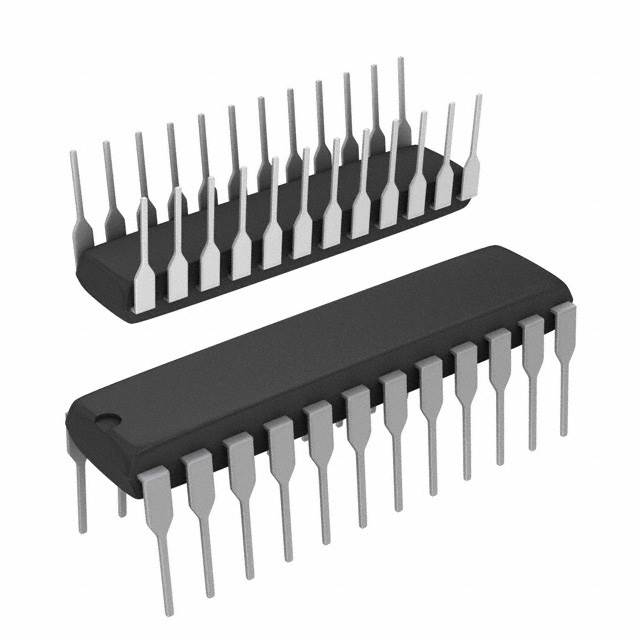Xem thông số kỹ thuật để biết chi tiết sản phẩm.

AD7579KN
Product Overview
- Category: Integrated Circuit (IC)
- Use: Analog-to-Digital Converter (ADC)
- Characteristics: High-resolution, low-power, serial interface
- Package: 28-pin plastic dual in-line package (PDIP)
- Essence: Converts analog signals into digital data
- Packaging/Quantity: Tube packaging, quantity varies
Specifications
- Resolution: 12 bits
- Sampling Rate: Up to 100 kilosamples per second (ksps)
- Input Voltage Range: 0V to Vref
- Power Supply: +5V
- Operating Temperature Range: -40°C to +85°C
Pin Configuration
The AD7579KN has a total of 28 pins. The pin configuration is as follows:
- VDD - Power supply voltage
- VREF - Reference voltage input
- AGND - Analog ground
- REFOUT - Reference output voltage
- IN1(+) - Positive input for channel 1
- IN1(-) - Negative input for channel 1
- IN2(+) - Positive input for channel 2
- IN2(-) - Negative input for channel 2
- IN3(+) - Positive input for channel 3
- IN3(-) - Negative input for channel 3
- IN4(+) - Positive input for channel 4
- IN4(-) - Negative input for channel 4
- IN5(+) - Positive input for channel 5
- IN5(-) - Negative input for channel 5
- IN6(+) - Positive input for channel 6
- IN6(-) - Negative input for channel 6
- IN7(+) - Positive input for channel 7
- IN7(-) - Negative input for channel 7
- IN8(+) - Positive input for channel 8
- IN8(-) - Negative input for channel 8
- CS - Chip select input
- SCLK - Serial clock input
- SDATA - Serial data output
- DGND - Digital ground
- VDD - Power supply voltage
- VREF - Reference voltage input
- REFOUT - Reference output voltage
- VDD - Power supply voltage
Functional Features
- High-resolution ADC with 12-bit resolution
- Low-power consumption, suitable for battery-powered applications
- Serial interface for easy integration with microcontrollers
- Wide input voltage range allows for versatile signal conversion
Advantages and Disadvantages
Advantages: - High resolution provides accurate digital representation of analog signals - Low-power consumption extends battery life in portable devices - Serial interface simplifies communication with microcontrollers
Disadvantages: - Limited sampling rate compared to higher-end ADCs - Restricted input voltage range may not be suitable for all applications
Working Principles
The AD7579KN is an analog-to-digital converter that converts continuous analog signals into discrete digital data. It utilizes a successive approximation register (SAR) architecture to achieve high-resolution conversion. The input analog voltage is sampled and held, and then the internal SAR circuitry compares it to a reference voltage. The conversion process iteratively approximates the input voltage until the digital output code accurately represents the analog input.
Detailed Application Field Plans
The AD7579KN can be used in various applications, including:
- Industrial Automation: Process control, data acquisition systems
- Medical Instruments: Patient monitoring, diagnostic equipment
- Communication Systems: Signal processing, base station control
- Test and Measurement Equipment: Oscilloscopes, spectrum analyzers
- Consumer Electronics: Audio equipment, instrumentation
Detailed and Complete Alternative Models
- AD7689 - 16-bit, low-power, SAR ADC
- ADS1115 - 16-bit, I2C interface, programmable gain amplifier
- MCP3208 - 12-bit, SPI interface, multiple input channels
- LTC2400 - 24-bit, differential input, low-drift ADC
- MAX11646 - 16-bit, internal reference, simultaneous sampling
(Note: This is not an exhaustive list of alternative models. Please refer to the manufacturer's documentation for a complete list.)
Word count: 436 words
Liệt kê 10 câu hỏi và câu trả lời thường gặp liên quan đến ứng dụng AD7579KN trong giải pháp kỹ thuật
Sure! Here are 10 common questions and answers related to the application of AD7579KN:
Q: What is AD7579KN? A: AD7579KN is a 12-bit successive approximation analog-to-digital converter (ADC) manufactured by Analog Devices.
Q: What is the operating voltage range for AD7579KN? A: The operating voltage range for AD7579KN is typically between +5V and +15V.
Q: What is the maximum sampling rate of AD7579KN? A: The maximum sampling rate of AD7579KN is 100 kilosamples per second (ksps).
Q: How many analog input channels does AD7579KN have? A: AD7579KN has 8 single-ended analog input channels.
Q: What is the resolution of AD7579KN? A: AD7579KN has a resolution of 12 bits, which means it can represent analog signals with 4096 discrete levels.
Q: Does AD7579KN require an external reference voltage? A: Yes, AD7579KN requires an external reference voltage for accurate conversion. It supports both unipolar and bipolar references.
Q: Can AD7579KN operate in a multi-channel mode? A: Yes, AD7579KN can be configured to operate in a multi-channel mode, allowing sequential conversion of multiple analog input channels.
Q: What is the interface used to communicate with AD7579KN? A: AD7579KN uses a parallel interface for communication with microcontrollers or other digital devices.
Q: Is AD7579KN suitable for low-power applications? A: Yes, AD7579KN has a power-down mode that reduces power consumption when the ADC is not actively converting.
Q: What are some typical applications of AD7579KN? A: AD7579KN is commonly used in industrial automation, data acquisition systems, medical equipment, and other applications requiring analog-to-digital conversion.
Please note that these answers are general and may vary depending on specific implementation details and requirements.

